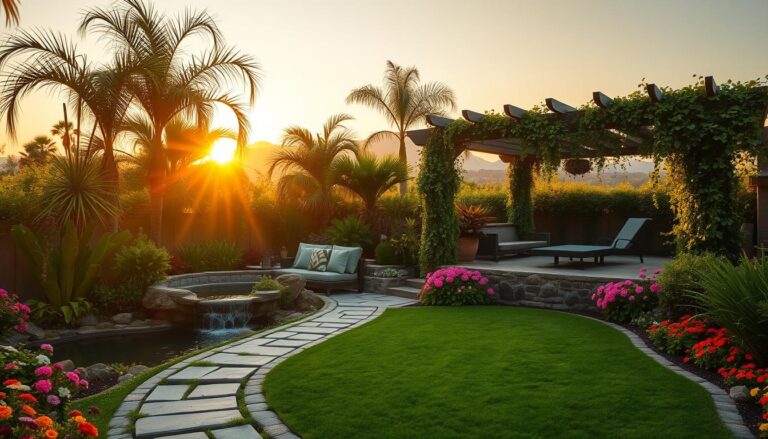Top 10 Best Raised Garden Beds For This Summer
This post contains affiliate links, meaning I may receive a small commission if you make a purchase through my links, at no extra cost to you.
Are you looking to elevate your gardening game this summer? You’ve come to the right place! Raised garden beds are a fantastic way to bring the joy of gardening to any yard. They allow you to grow a variety of plants in a controlled environment. This makes it easier to maintain and harvest your crops.
You can place a raised garden bed in a sunny spot. With the right soil and care, you’ll be enjoying fresh produce in no time. Raised garden beds are perfect for growing vegetables, herbs, and flowers. They can be customized to fit any space.
Key Takeaways
- Easy to set up and maintain
- Customizable to fit any yard size
- Perfect for growing a variety of plants
- Controlled environment for optimal growth
- Accessible for gardeners of all levels
Introduction to Raised Garden Beds
Learn about the perks of raised garden beds for your gardening. Raised beds offer many benefits over traditional gardening.
What Are Raised Garden Beds?
Raised garden beds are plots of soil in frames. They let gardeners grow many plants. You can make them from wood, metal, or plastic, in various sizes.
Benefits of Using Raised Garden Beds
One big plus is better drainage. This stops waterlogged soil, which harms plants. Raised beds also avoid soil compaction since you access them from the sides.
They’re also good for your back. Raised beds make gardening easier by not needing to bend. Plus, they’re perfect for DIY garden beds projects, letting you be creative.
Looking for raised bed ideas? There are many options. From simple wooden frames to complex metal or plastic designs. Raised beds fit any garden size or style, great for all gardeners.
Selecting the Right Size for Your Garden
Choosing the right size for your raised garden bed is key. The size affects the plants you can grow, how much care it needs, and your garden’s look.
Standard Sizes Available
Raised garden beds come in many standard sizes. You can find 4×4 feet, 4×8 feet, and 2×8 feet beds. These sizes are great for most backyards and offer enough room for many plants.
| Size | Area (sq ft) | Ideal For |
|---|---|---|
| 4×4 feet | 16 | Herbs, small vegetables |
| 4×8 feet | 32 | Variety of vegetables, flowers |
| 2×8 feet | 16 | Narrow spaces, vertical gardening |
Considerations for Limited Space
If space is tight, there are still ways to have a great raised garden bed. Think about using a 2×8 feet bed or stacking beds to save space. You can also use a corner bed to make the most of corner spaces.

As a gardening expert,
“The key to a successful small garden is not just about the size, but how you utilize the space available.”
–
. Use trellises for climbing plants and pick compact varieties. A good companion planting strategy also helps make the most of your space.
When planning your bed, think about how big your plants will get. Make sure they have enough room to grow well without being too crowded. This helps pick the perfect size for your bed, whether it’s small or big.
Materials Used for Raised Garden Beds
Raised garden beds can be made from many materials. Each has its own good and bad points. The material you choose can change how long your bed lasts, how it looks, and your gardening experience.
Wood vs. Metal vs. Plastic
You can pick from wood, metal, or plastic for your raised bed. Each has its own special qualities that can make your garden better or worse.
- Wood: Wooden beds are loved for their natural beauty. They can be cedar or pine. Cedar is great because it lasts long and fights off rot and bugs. But, wood needs more care because it can rot if not treated right.
- Metal: Metal beds look modern and sleek. They’re often aluminum or steel and last longer than wood. They also help with water flow and can be pretty. But, metal gets hot in the sun, which can hurt plant roots.
- Plastic: Plastic beds are light, easy to put together, and cheaper than wood or metal. They don’t rot and can be made from recycled stuff. But, plastic isn’t as strong as other materials and can break with age.
Think about your garden ideas, the weather, and what you like when picking a material. For example, if it rains a lot where you live, choose something that doesn’t rot or decay easily.
Environmental Impact of Different Materials
It’s important to think about how your raised bed affects the planet. Different materials have different effects, from making them to getting rid of them.
Wood is natural and can be renewed, but treating it can use chemicals. Metal making uses a lot of energy and takes resources. Plastic comes from oil and can pollute if not thrown away right.
To be kinder to the earth, use recycled or eco-friendly materials. Try to reuse or repurpose things to cut down on waste. This helps your garden be better for the planet.

Choosing the right material for your raised bed makes your garden beautiful, useful, and good for the earth. It meets your needs and makes your outdoor space better.
Top Features to Look For
Finding the right raised garden bed can change your gardening game. What features should you look for? When setting up a garden, the right raised bed is key. Whether it’s for raised flower beds in your yard or along a fence, certain features are essential.
Drainage Options
Drainage is a must-have for a raised garden bed. It keeps your plants watered but not soggy. Look for beds with holes or slits to let water out. This is crucial in rainy areas or for plants that don’t like too much water.
Some beds have adjustable drainage. This lets you tailor water flow to your plants’ needs. It’s great for gardens with different plants.
Accessibility and Height
The bed’s height and ease of access matter a lot. Choose a bed that’s easy to reach, especially if you have mobility issues. Raised beds are good for those with back problems because they reduce bending.
Think about the bed’s width and depth too. A wider bed might need extra support, while a deeper one is better for deep-rooted plants. Make sure your bed is deep enough for your plants’ roots.
Pest Resistance
Pest resistance is important when picking a raised garden bed. Some materials, like cedar, are better at keeping pests away. Cedar wood, for example, is great for raised beds because it resists insects and rot.
Look for beds with built-in pest protection, like hardware cloth. This helps keep pests out without needing harsh chemicals. It makes your garden healthier for your plants.

By focusing on these features, you can find a raised garden bed that’s perfect for you. Whether it’s for a fence garden or a yard corner, the right bed makes a big difference.
Review of the Best Raised Garden Beds
Looking to start or upgrade your gardening? Check out the top-rated raised garden beds. With many options, picking the right one can be tough. We’ll look at some of the best, highlighting their features and benefits.
1. Greenes Fence Cedar Raised Garden Bed
The Greenes Fence Cedar Raised Garden Bed is a favorite among gardeners. It’s made from durable cedar wood, resistant to rot and insects. The cedar’s natural aroma also repels pests, making it healthier for plants.
The modular design lets you customize the size and layout. This makes it perfect for your needs.

This bed is great for drainage. Its elevated design improves water circulation, reducing waterlogged soil. You can use a garden divider to separate plants or sections, making garden management easier.
2. Vegtrug Elevated Garden Bed
The Vegtrug Elevated Garden Bed is a top choice for raised gardening. It’s made from durable, BPA-free plastic, designed to last. The elevated design makes it easy to access and maintain plants, reducing back and knee strain.
It has excellent drainage thanks to its design. You can fill it with soil, compost, and mulch. It’s perfect for small spaces, fitting on balconies, patios, or small backyards.
3. Lifetime Outdoor Garden Raised Bed
The Lifetime Outdoor Garden Raised Bed is for serious gardeners. It’s made from high-quality, UV-resistant plastic, built to last. The design is easy to assemble, getting you gardening quickly.
For a DIY look, consider a cinder block raised garden bed. You can create a bed using cinder blocks, fitting your space and design. It’s a cost-effective, customizable option for gardeners.
When choosing a raised garden bed, think about material, size, and drainage. The right bed can make your garden healthier and more productive. Whether you choose a pre-made bed or DIY, raised gardening offers many benefits.
How to Assemble Your Raised Garden Bed
Building your own garden beds is fun and rewarding. You can grow strawberries or your favorite veggies. Assembling a raised garden bed is easier than you think. We’ll guide you through it.

Tools You’ll Need
Before starting, gather the right tools. You’ll need a screwdriver, wrench, and maybe a hammer. Also, have a measuring tape and rubber mallet for fitting parts together.
- A screwdriver for driving screws
- A wrench for tightening bolts
- A hammer for tapping parts into place
- A measuring tape for verifying dimensions
- A rubber mallet for gently fitting components together
Step-by-Step Assembly Guide
Now, let’s get to assembling. Most raised garden beds are easy to put together. They come with pre-cut wood and simple instructions.
- First, lay out all parts and check if you have everything.
- Then, follow the instructions to build the frame. This usually means attaching sides and bottom with screws or bolts.
- Make sure the frame is square and corners are tight.
- Add any extra features, like a trellis or irrigation system, as instructed.
- Finally, place your bed where you want it and fill it with soil. Now, you’re ready to plant your strawberries or other plants.
By following these steps, you’ll enjoy a raised garden bed’s benefits. These include better drainage, soil structure, and easy plant access. Whether you’re new to gardening or experienced, a DIY garden bed is a great choice. It lets you grow your own food and enjoy the outdoors.
Soil Preparation Tips for Raised Beds
Getting your soil right is key to a great raised garden bed. You need to pick the best soil mix and add nutrients for your plants to thrive.
Choosing the Right Soil Mix
Finding the right soil mix is vital for your raised bed’s success. Look for a mix that drains well, is rich in organic matter, and has the right pH for your plants. It should also be free of weeds and contaminants. A mix made for raised beds is a good choice because it’s tailored for these gardens.
You can also make your own soil mix using topsoil, compost, and other organic materials. This way, you can tailor the mix to your needs and save money. But, you need to know how to mix the ingredients correctly.

Adding Nutrients for Healthier Plants
Along with the right soil mix, your plants need the right nutrients to grow well. Adding fertilizers or amendments can help. Organic options like compost, manure, or fish bone meal are great because they release nutrients slowly and help the soil.
Think about what your plants need. Vegetables and fruits need more nitrogen, phosphorus, and potassium than herbs or flowers. Knowing this lets you choose the right fertilizers for your plants.
Other raised bed ideas to improve soil fertility include growing cover crops, using crop rotation, and adding beneficial microorganisms. These methods help create a balanced and healthy garden ecosystem.
By following these raised garden layout tips and focusing on soil preparation, you can make a productive and healthy raised garden bed. It will give you a rich harvest for months.
Planting Strategies for Raised Garden Beds
Getting the most from your garden starts with smart planting. It’s key for a healthy garden, whether you’re growing veggies, herbs, or flowers. This includes using raised flower beds and creative ideas like tiered planter boxes.
Companion Planting Techniques
Companion planting pairs different plants to boost their growth and health. For example, marigolds help keep nematodes away from tomatoes. Basil not only keeps aphids off but also makes veggies taste better. This approach adds variety to your garden and cuts down on pesticide use.
Some great pairs include:
- Tomatoes and basil
- Cucumbers and dill
- Carrots and sage
- Marigolds and tomatoes
Using companion planting helps your garden grow strong and healthy. It leads to a more fruitful harvest.
Crop Rotation Ideas
Crop rotation keeps your soil healthy and fights pests and diseases. It adds nutrients, improves soil, and stops pests and diseases from coming back. For instance, beans and peas fix nitrogen, which helps plants like leafy greens grow well.
| Crop Rotation Cycle | Benefits |
|---|---|
| Legumes (e.g., beans, peas) | Nitrogen fixation |
| Leafy Greens (e.g., lettuce, spinach) | High nitrogen requirement, benefits from legume rotation |
| Root Vegetables (e.g., carrots, beets) | Breaks disease cycles, improves soil structure |
A good crop rotation plan boosts your garden’s productivity and lasts longer. Make a plan that fits your climate and the crops you want to grow.

Using these strategies can make your garden more fruitful and diverse. Whether you’re new to gardening or have experience, these tips will help you get the most from your garden. This includes using tiered planter boxes and other creative ideas.
Seasonal Maintenance for Raised Garden Beds
Summer is here, and your raised garden bed needs extra care. Regular upkeep keeps your garden looking great and growing well. A well-cared-for raised bed also means a bigger harvest.

Watering Practices in Summer
In summer, your raised garden bed needs enough water to grow. It’s important to keep the soil moist but not too wet. Check the soil by feeling it with your finger; if it’s dry, it’s time to water.
Using a drip irrigation system or soaker hose helps. These methods water the roots directly, saving water. They’re great for small gardens, making sure plants get the right amount of water.
Tips for Effective Watering:
- Water in the early morning or late evening to cut down on evaporation.
- Don’t water the leaves to avoid fungal diseases; water at the soil level instead.
- Change your watering schedule with the weather, watering less when it rains.
Pest and Weed Control Methods
Summer brings more pests and weeds to your raised garden bed. It’s important to control them to protect your plants. Use physical barriers or organic pest control to keep beneficial insects safe.
Check your garden often for pests or weeds. Act fast when you find them. Hand-weeding, using mulch, and introducing beneficial insects are good ways to control them.
“A garden is a grand teacher. It teaches patience and care. It teaches us as much about ourselves as about the plants.” –
Anthony Smith
By following these tips, your raised garden bed will thrive in summer. A little care makes a big difference in your garden’s success.
Conclusion: Growing Success with Raised Garden Beds
Thinking about starting or improving your garden? Raised garden beds are a great choice. They make growing your favorite plants easy and rewarding. With the right care, these beds can give you a lot of food and a lovely outdoor area.
Keeping an eye on your raised garden beds is key to their success. Check the soil moisture, watch for pests, and adjust as needed. This way, your plants will do well, and you’ll enjoy all the benefits of raised garden beds.
Start Your Garden Journey
Whether you’re new to gardening or have experience, raised garden beds are a fantastic option. They offer better drainage and are easy to reach, making them popular among gardeners. So, why not plan your garden today? Start growing your own food and flowers in your raised garden beds.
FAQ
What is a raised garden bed?
A raised garden bed is a bed that sits higher than the ground. It uses a frame or container to hold the soil. This design helps with drainage, keeps the soil warm, and makes gardening easier.
What are the benefits of using a raised garden bed?
Raised garden beds improve drainage and reduce soil compaction. They also keep the soil warmer. Plus, they’re easier to access, which means less bending or kneeling.
How do I choose the right size for my raised garden bed?
Think about the space you have and the plants you want to grow. You can pick a standard size or make it custom. For small spaces, consider a tiered planter box or a compact bed.
What materials are used for raised garden beds?
You can make raised garden beds from wood, metal, or plastic. Each has its own benefits and drawbacks. Think about durability, looks, and environmental impact when choosing.
How do I assemble a raised garden bed?
You’ll need a screwdriver and a wrench to put one together. Follow the instructions or try a DIY project with cinder blocks or reclaimed wood.
What is the best soil mix for a raised garden bed?
The best soil mix drains well and is full of nutrients. Add organic matter like compost to help plants grow strong.
How do I maintain my raised garden bed?
Keeping your raised garden bed in good shape is important. Water, fertilize, and control pests and weeds regularly. Adjust your watering in summer to keep your garden healthy.
Can I use raised garden beds for growing strawberries?
Yes, raised beds are great for strawberries. Use a compact bed or a tiered planter to save space and promote growth.
How can I control pests and weeds in my raised garden bed?
Use physical barriers like row covers and organic methods like neem oil to control pests and weeds. Planting marigolds or basil can also help keep pests away.
Can I build a raised garden bed along a fence?
Yes, you can build a raised bed along a fence. It’s a beautiful and useful gardening spot. Use a kit or DIY with reclaimed wood or cinder blocks for a unique look.







